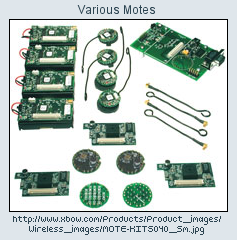Successful robot autonomy on a farm requires retrieval of field data, processing the data, and correct condition-based actions. As described in the research of current robotic technology, just sensing what's out there is an enormous hurdle to robots. With diverse fields, large amounts and, not to mention, different types of data must be considered in management. The first problem would be getting the data from the field to the robots. There are a few approaches to doing this. Robots could be equipped with a multitude of sensors and collect data directly from the field as they pass through the field. However, sensors consume processing power and electrical power, both of which are limited in a robot. Not only would having a robot cover acres of land, while collecting data every few feet, result in slow, inefficient use power and time but would require overcoming significant technical hurdles.
A more efficient option would be to embed the field with cheap, small, wireless sensors to create a wireless sensing network. In this design, wireless remote sensors, known as motes, are spread across the field. These motes, designed for environmental conditions, contain sensors for environmental conditions such as temperature, humidity, and soil conditions. By transferring some of the burden of data collection from the robot to the wireless sensors, robots have more power available for their own operations. The motes obtain their power from small amounts of thin, photovoltaic film. To conserve power, motes spend most of the time in sleep mode. Master robots, described later,  can collect motes from the field for storage or maintenance of motes. The sensor network will collect data on air conditions, light conditions, and soil conditions. Instead of looking for nutrient deficiencies symptoms in plants, the sensors will detect if the nutrient levels are too low in the soil for the particular plant species.
can collect motes from the field for storage or maintenance of motes. The sensor network will collect data on air conditions, light conditions, and soil conditions. Instead of looking for nutrient deficiencies symptoms in plants, the sensors will detect if the nutrient levels are too low in the soil for the particular plant species.
As a robot, specifically a hunterbot described later, passes by a mote, the robot sends a packet to the mote and receives the mote's sensor data. The robot stores the data temporarily and passes to a base station for storage and processing upon return to the base station. Based on the data originally provided by the sensor network of motes, robot management of the base station decides what treatment to apply to the field. For the minimal amount of management required for the polyculture field, robot management will decide to irrigate, fertilizer locally, weed, plant or harvest.
 can collect motes from the field for storage or maintenance of motes. The sensor network will collect data on air conditions, light conditions, and soil conditions. Instead of looking for nutrient deficiencies symptoms in plants, the sensors will detect if the nutrient levels are too low in the soil for the particular plant species.
can collect motes from the field for storage or maintenance of motes. The sensor network will collect data on air conditions, light conditions, and soil conditions. Instead of looking for nutrient deficiencies symptoms in plants, the sensors will detect if the nutrient levels are too low in the soil for the particular plant species.